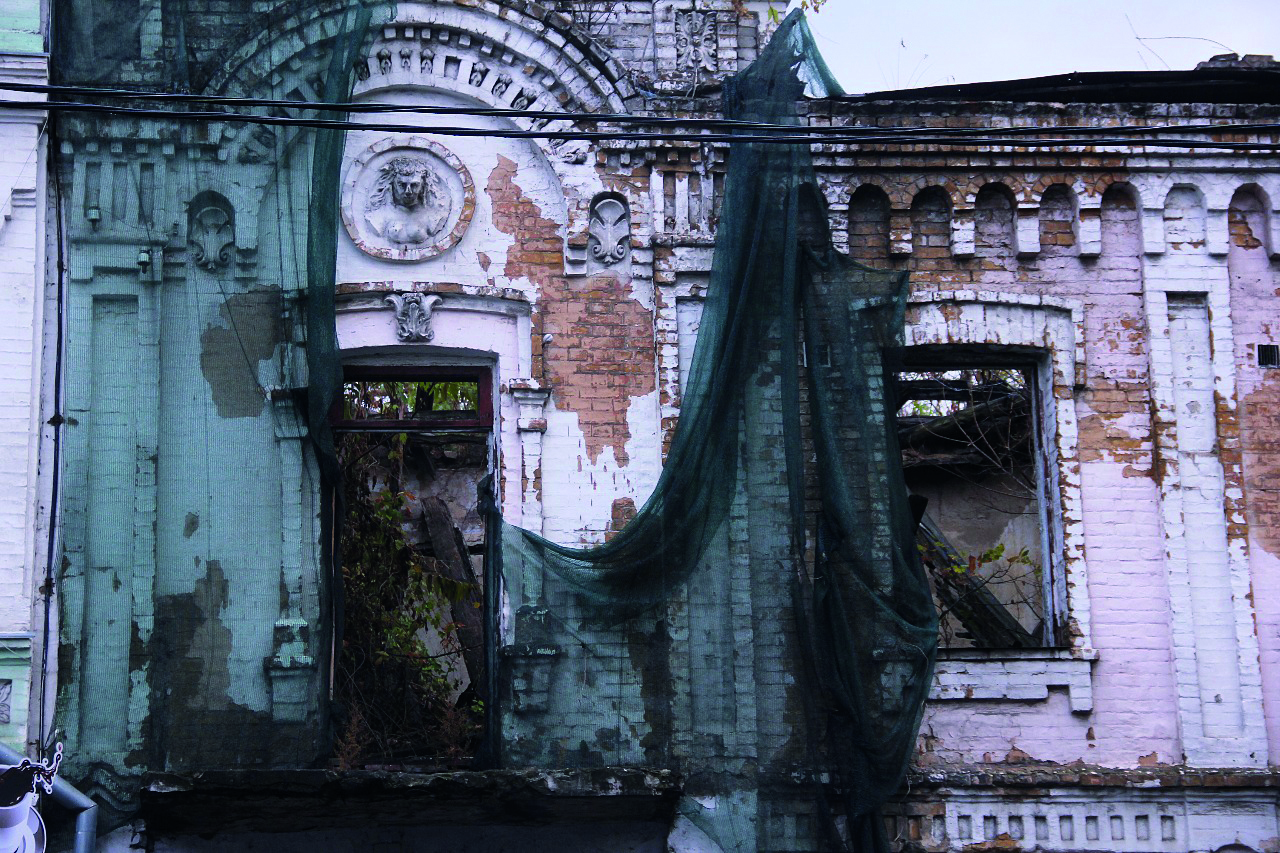Artists in Exile

This spring marks four years since Crimea was annexed and large swathes of the Donetsk and Luhansk regions of Ukraine were occupied by pro-Russian terrorists. Four years since hundreds of thousands of Ukrainians were forced to leave their hometowns and start a new life elsewhere. What’s On meets with three artists who lost their homes only to find new ones in Kyiv.
 Risk and Provocation
Risk and Provocation
Maria Kulikovska is an artist who responds to important social transformation with a courage worth admiration, by putting her body on the line – literally. Her art performances usually feature her own body, risk, and provocation. A nominee for the PinchukArtCentre Prize in 2013, her nude female sculptures made of soap were widely exhibited in Ukraine and abroad. While she herself is from the town of Kerch, Crimea, she happened to be abroad when the annexation took place purely by chance. Over the course of these last four years, the pain of losing her home has become a feeling and experience to reflect on in her artistic work.
“I thought I would go crazy after the annexation and even attempted suicide,” Kulikovska recalls. As she recounts this, she is the epitome of a carefree artist, dressed in a long gown bedazzled with flowers, her blond hair tied up carelessly. Yet, she is astonishingly frank and direct in expressing her feelings. “In spring 2014, I had nowhere to live in Kyiv, and there was no chance of returning to Crimea. My parents would Skype from Kerch, telling me how many armed forces were there, and when I told people in Kyiv they simply did not care. And at the same time, some absolutely random people would offer help. One lady, who saw my works at Pinchuk Centre let me live in her old empty apartment in Kyiv. It was true happiness – my parents and I lived there for more than two years, but my elderly grandmother told us she wanted to die in her own at home, so they went back to Kerch.”
The first art performance she did after losing her home was “254” – based on the number of her family’s application for IDP (internally displaced person) status. “On 1 July I lay down on the stairs of the Hermitage Museum in St Petersburg covered with a Ukrainian flag like a dead body.” She vividly remembers her fear lying under the flag. “Then a guy came by and said, ‘May I sh*t on you?’ I can’t imagine how the flag of another country can bring about such a reaction. I realised then the performance was worth it. I was later taken by guards who said the Ukrainian flag insulted them and they would take me to a psychiatrist because although I insisted I was Ukrainian, they saw I was born in Crimea.” As she tells it, she recently registered herself in a small flat in Kyiv her family managed to buy, and “since then I really believe I have lost my home”. The memories remain, however. “I still love looking at old photos of Kerch, when it was Ukrainian – mine. I have since decided that my home is where I live – it is often Kyiv, sometimes Liverpool or Malmo, Sweden. Wherever I go I keep noticing how this or that city is like Kerch,” Kulikovska says, tears in her eyes.
 The Ukrainian ‘Banksy’
The Ukrainian ‘Banksy’
Serhiy Zakharov is also called the “Banksy from Donetsk” for his graphic street works mocking the terrorists of DNR. One of the graphics that appeared on the streets of Donetsk in summer 2014 depicted the leader of the DNR holding a gun to his head with the phrase “Just do it” underneath. When we first met with Zakharov in autumn that same year, he had just left his home city after being held in captivity for two weeks in one of the terrorist’s basements. He looked absolutely lost and we were horrified to hear the torture he’d endured. Four years’ on, he has rallied and even looks the part of an artist, with a small beard and a scarf around his neck. He has mounted exhibitions in Berlin, Prague, and other European cities, and has projects in mind in cooperation with the self-proclaimed ‘Republic of Uzupis’ – the artistic neighbourhood in Lithuania’s capital Vilnius.
“When you come back to life after captivity, journalists attack you, trying to pull out the most disturbing memories. At that time, I was as desperate as any other IDP – no place to live, no job, no money. To overcome the post-captivity shock, I had to put that nightmare on paper, so I started a graphic novel The Hole, drawing on each episode – the beatings, long hours without food or water, fake executions.”
 The book was published in Ukrainian and now has an English-language edition. “As an IDP, all I received in state aid in those first six months was 400 UAH. But all that horror had a positive side – it let me work and earn a living as an artist, something that was not possible back in Donetsk, where I tried a number of different professions.”
The book was published in Ukrainian and now has an English-language edition. “As an IDP, all I received in state aid in those first six months was 400 UAH. But all that horror had a positive side – it let me work and earn a living as an artist, something that was not possible back in Donetsk, where I tried a number of different professions.”
He says Kyiv is now home: “I rent an apartment here, a friend of mine on Podil turned part of his flat into a gallery where we organise exhibitions, and I feel really comfortable here. There is no chance I could ever go back to Donetsk – I’m on the list of enemies of the DNR. Sometimes I walk around Donetsk in Googlemaps: I walk past my house, I even saw my father once – no face was visible, but I recognised his footstep. Strange thing – the camera travelled between garages and I read on the fence ‘Donbas is Ukraine’ – that video dates back to 2011.”
 A High Price
A High Price
“Artist loses $1 million in occupied Donbas,” reads one headline about sculptor Petro Antyp. Born in Horlivka, Antyp worked there for many years and became a well-respected artist who exhibited all over Ukraine and Europe. In his hometown, he managed a huge factory that supplied all stages of large-scale sculpture production. The 59-year-old artist just left it all one day in spring 2014.
“I knew there would be war long before the occupation,” Antyp says calmly, almost matter-of-factly. His voice is soft and he mixes Ukrainian and Russian in a very natural way. “The decision to leave, though, was immediate – we took documents and family photographs and ran. In a couple of days, our house in Horlivka was bombed and later, neighbours sent some remaining stuff. A friend of mine let me live in his country house near Kyiv – I thought Donbas would quickly be Ukrainian again. When my illusions faded I rented an apartment and said to myself ‘it’s time to start a new life’.”
Still, his mind turns to home. “In Horlivka I had an incredible workshop: a spacious building and several acres of a park with sculptures. As each artwork has its own fate, just like man, my works remain in Horlivka. The 25 000 square metre factory I managed is totally ruined – the local DNR terrorists took down the metal fence and took it…where? To (Rinat) Akhmetov’s factory for money. I did not pay a single hryvnya of taxes to the DNR, but they say I owe them a million rubles. Now I have a workshop not far from Kyiv – it’s small, compared to the one I had in Horlivka, but enough for paintings and smaller-scale sculptures.”
Despite this, war does not figure in his work. “I don’t want to depict war or occupation; I want to work with notions like faith, conscience, and the ancient history of Ukraine. Do you know why so many Ukrainians leave this country? Because they don’t know its history – they simply don’t realise how cool and powerful we are. They say Donbas is industrial. Nonsense! Donbas is the steppe – I feel a deep connection with the endless wideness and power of it, that’s why I can’t live abroad.”
He says he is proud to be from Horlivka and believes it will be Ukrainian again, “only we’ll have to throw out all the oligarchs from ruling the country”.
“Do you know why so many Ukrainians leave this country? Because…they simply don’t realise how cool and powerful we are”
“There is no chance I could ever go back to Donetsk – I’m on the list of enemies of the DNR”
“Then a guy came by and said, ‘May I sh*t on you?’ I can’t imagine how the flag of another country can bring about such a reaction”











